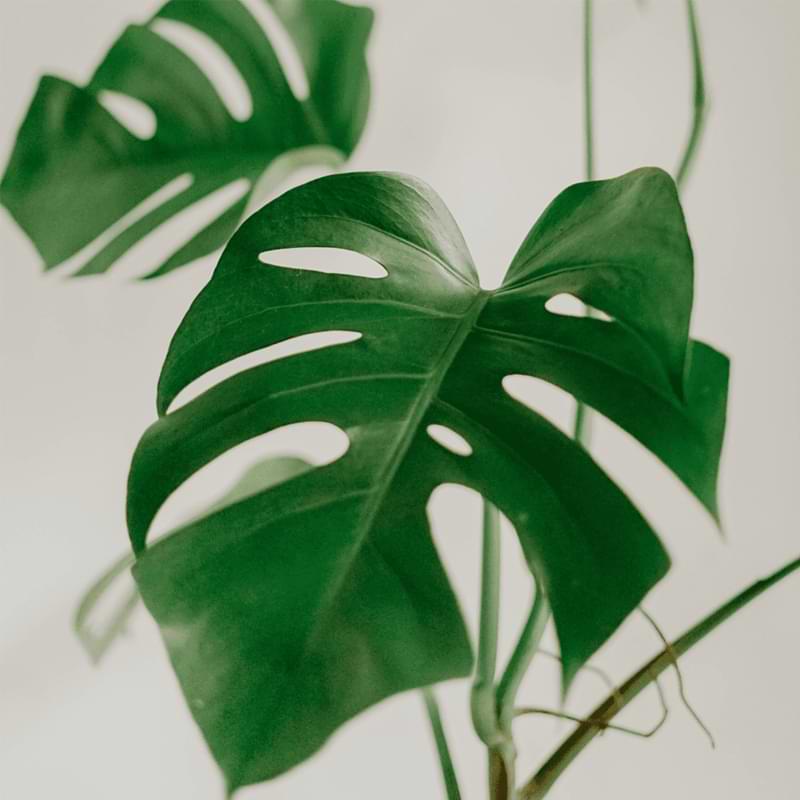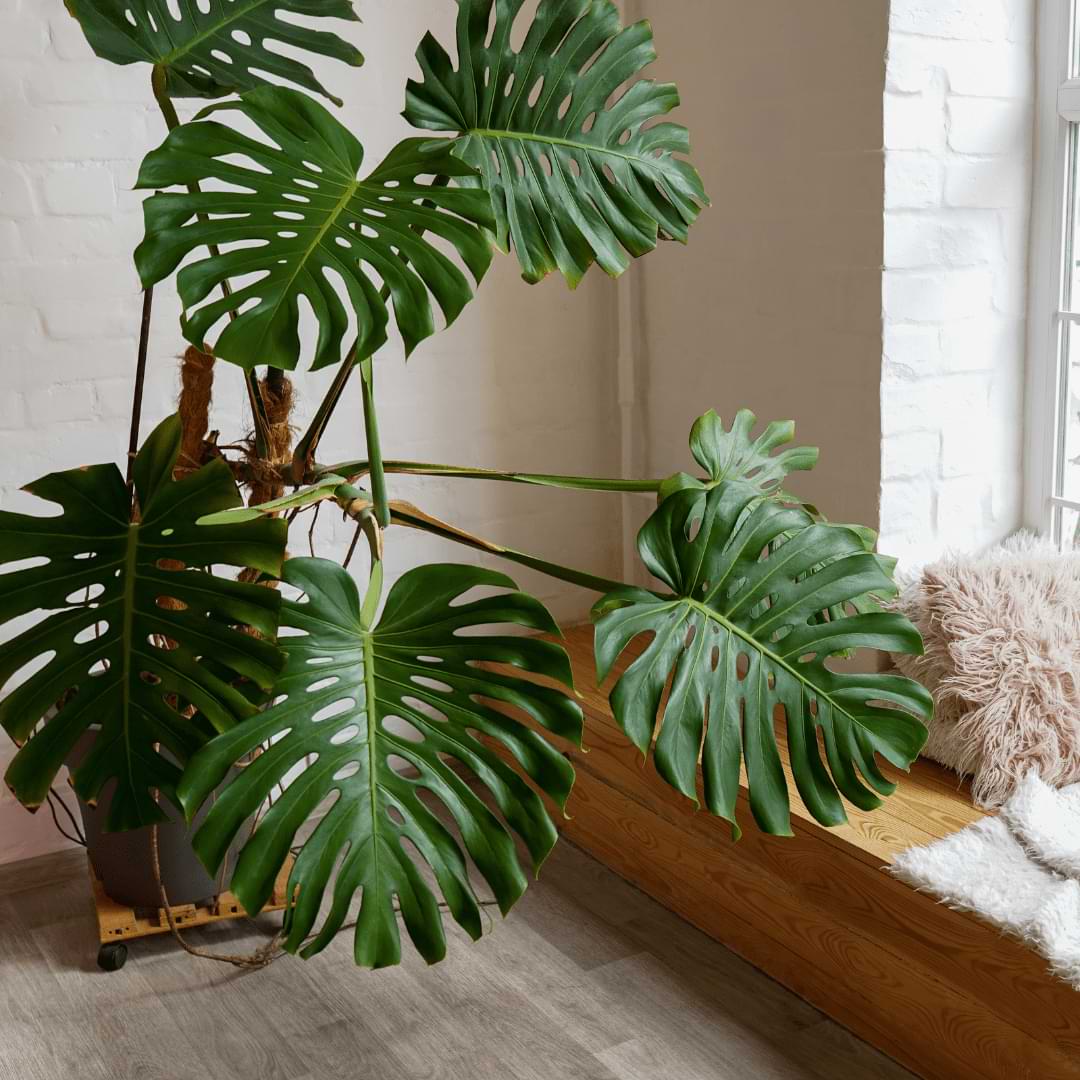Table of Contents
Reasons for Leggy Monstera Growth and How To Fix It
With all the love, care, and effort you put into growing Monstera plants at home, nothing is more heartbreaking than seeing them grow weak and leggy instead of with their signature lush, green, and glossy leaves. But while leggy Monstera growth is distressing, it isn’t uncommon, and fortunately, it’s also very fixable.
Leggy Growth on a Monstera Plant: What It Looks Like
A healthy Monstera is tall with thick, sturdy stems and big, waxy leaves. However, if your plant is showing the following signs, you may have leggy growth:
- Long, spindly stems with large gaps between the leaves
- Small and sparse leaves that are few and far between
- Unable to support its own weight and appears to be falling over
- Growth towards any light source, even if it means stretching out in an unnatural direction
These warning signs can be individually or collectively responsible for leggy growth. If you notice these issues, the first thing to do is understand all possible causes before enacting any solution that restores your Monstera to its robust, vibrant state.

5 Causes of Leggy or Stretched Monstera
Low Light Conditions
Monstera plants need bright, indirect light to thrive. But when put in areas that don’t get sufficient light, such as a dimly lit room or too far from a window, the plant will stretch out in search of more light. This unnecessary strained growth leads to long stems and sparse leaves, resulting in leggy growth.
Excessive Fertilizing
When giving Monstera plant food or fertilizer during its active growing season in the spring and summer, you end up with healthy growth. However, fertilizing too often or in its inactive seasons can affect the nitrogen levels in the soil, throwing plant growth into overdrive and leading to that unappealing leggy look.
Extreme Temperatures
Like people, plants can cool themselves down when they’re too hot through a process called transpiration. While this process can be a normal and healthy way for plants to regulate their temperature through increased nutrient and water uptake, in extreme temperatures outside of its optimal range, a Monstera becomes stressed and stretches out in response, resulting in leggy growth.
Pot Bound Roots
Roots need room to grow and spread to support the plant’s above-ground growth. If a Monstera plant is kept in a container that’s too small for extended periods, its roots can become pot-bound, meaning they have reached the edge of their container and are circling around themselves or pushing out of the bottom of the pot. This prevents proper nutrient absorption, resulting in a Monstera prioritizing height growth over leaf growth, leading to leggy growth issues.
Pests
The bane of all houseplant owners, pests don’t just cause physical damage to plants; they can also cause nutrient deficiencies that lead to leggy growth. Pests such as spider mites or mealybugs, in particular, are known to damage plant tissues and consume nutrients, causing anything from stunted growth to leggy and weak stems.
Tips To Prevent Leggy Growth On Monstera Plants
Improve Lighting
Monstera plants in their natural habitat have evolved to thrive in filtered sunlight under a canopy of trees. As such, moving your plant to a brighter room with plenty of windows but still out of direct sunlight may be all it takes to prevent leggy growth.
If you don’t have a spot to place your Monstera in bright, indirect light, consider investing in a grow light to provide the necessary intensity and spectrum for proper growth. Many Monstera owners have found that UFO growing lights that provide 360 degrees of light coverage are more effective than traditional grow lights, and they come with less risk of burning your plant.
Fertilizer Usage
The key to effective fertilizing lies in understanding your Monstera’s active and inactive growth periods. During active growth cycles in the spring and summer months, it’s essential to use a balanced fertilizer bi-weekly or monthly that includes equal parts nitrogen, phosphorus, and potassium (NPK). This will help promote healthy, fuller leaf growth and prevent the plant from redirecting all its energy towards height.
During inactive periods in the fall and winter months, fertilization often isn’t necessary as your plant needs time to rest and prepare for the next growing season. However, if you start to notice signs of nutrient deficiency, such as yellowing leaves or slow growth, you can consider giving it a plant multivitamin that includes micronutrients such as iron, boron, zinc, and other macronutrients known to support plant health and prevent disease during its dormant stage.
Temperature & Humidity
While it’s hard to think of the Monstera as having been anything other than one of the world’s most popular houseplants, the species are actually native to the tropical forests of Mexico and Central America. This means they thrive in warm, humid conditions like their natural habitat. To mimic this environment, keep the ambient temperature where the Monstera is kept between 65-85 degrees Fahrenheit with humidity levels around 40-60%.
Some climates won’t naturally provide these conditions, so to create the perfect environment for your Monstera, consider investing in a humidifier or placing a tray of pebbles and water underneath the plant to increase humidity levels. Additionally, misting the leaves can provide extra moisture to keep your Monstera happy.
Pro Tip: It is important to remember that too much water or humidity can lead to increased soil moisture and cause root rot, so be sure to invest in a high-quality moisture meter to ensure your Monstera is living in its ideal conditions.
Repotting
Repotting is critical in houseplant care, and Monstera deliciosa is no exception – especially if pot-bound roots are causing leggy Monstera growth. If it’s been a year or more since you last re-potted your Monstera, it may be time to give it more room to grow. Early spring is the ideal time of year to repot as this is when a Monstera enters its most active growth phase and can handle the stress of being repotted.
The process to re-pot a Monstera is simple – gently remove the plant from its current pot and shake off any excess soil. Look for any signs of rot or disease on the roots, trimming anything damaged or dead with clean scissors. Then, place the plant in a new pot that is one size larger, filling in with fresh potting mix around the roots. Be sure to water thoroughly after repotting to help the plant adjust and encourage new root growth.
Regular Checks for Pests & Diseases
One of the best ways to ensure your Monstera stays healthy is by regularly checking for pests and signs of disease. You can tell that your Monstera may have a pest or disease-related infestation if you notice discoloration, wilting, or unusual spotting on the leaves. By catching and treating any issues early on, you can prevent them from reducing nutrient absorption, which leads to leggy Monstera growth.
Incorporating houseplant leaf shine wipes specially formulated for foliage houseplants into your regular checks is also a great idea. This formula is specially designed to enhance the overall look of your Monstera’s leaves and creates a protective barrier that can help prevent pests or diseases from taking hold. A leaf shine spray can also help keep the leaves clean and free of dust that hinders photosynthesis and creates many issues, including leggy growth.
Pruning
Taking time to prune a Monstera helps promote fuller, healthier growth. With less energy directed towards damaged or dying leaves and branches, the plant can put more resources into producing robust and new growth. Pruning should always be done in small increments, and it’s often best to do it in the springtime when the plant is in its active growing season.
The key to successful pruning is to be strategic and always use sharp, clean pruning shears. Start by removing any dead or damaged leaves and cut at the base where the leaf meets the stem. Then, take a step back and assess your plant’s overall shape and density. Look for areas needing more light or air circulation and prune accordingly. Additionally, you can selectively prune to encourage new growth in certain areas, such as the top of the plant, for a fuller appearance.
Using Trellis or Moss Poles As Support
Supporting your leggy Monstera with a trellis or moss pole can help improve its overall appearance and encourage stronger, more upright growth. These supports mimic the natural conditions of a Monstera’s native habitat, where they grow up trees and other structures for support and stability.
When using a trellis or moss pole, secure it firmly in the soil and gently guide the plant onto it as it grows. You can also use soft gardening twine or clips to help train the plant’s growth along the support. It’s essential to regularly check and adjust the supports as needed, especially as your Monstera grows taller and heavier.
Frequently Asked Questions
- Why is leggy growth bad for Monstera plants?
Leggy growth makes the plant vulnerable to damage, disease, or even collapse under its own weight. Furthermore, leggy growth can also affect the plant’s appearance by creating an unbalanced and less aesthetically pleasing look.
- How much of my Monstera should I prune?
There is no specific rule for how much of a Monstera should be pruned, as it ultimately depends on the individual plant’s needs and desired appearance. However, a good guideline is to remove up to one-third of the plant’s overall growth at any given time.
- Will a root supplement stop leggy growth?
While a root supplement can provide the necessary nutrients for overall plant health, it is not a solution for stopping leggy growth. The best way to prevent legginess in your Monstera is by providing proper lighting, pruning regularly, and using supports if needed.
- Can I propagate the pruned leaves from leggy plants?
Propagation is possible but only if the pruned leaves have nodes and are not too damaged from being leggy. If you want to propagate these leaves, make sure to cut just below a node and place the cutting in water or moist soil until roots develop. Once rooted, you can transfer the new plant to a pot with well-draining soil.
Say Goodbye To Leggy Monstera Growth
Congratulations! You now have the knowledge and tools to bid farewell to leggy Monstera growth and create a thriving indoor oasis. But creating the perfect growing environment is only one step in the art of Monstera care.
To truly master the skills needed to keep your plant happy and healthy, become part of a thriving Monstera community and subscribe to our newsletter and Facebook community for tips, tricks, and support from fellow plant lovers.
Furthermore, with the Monstera Care webinar and high-quality products available only from the Monstera Plant Resource Center, you can ensure healthy growth and stunning appearance for years to come.





